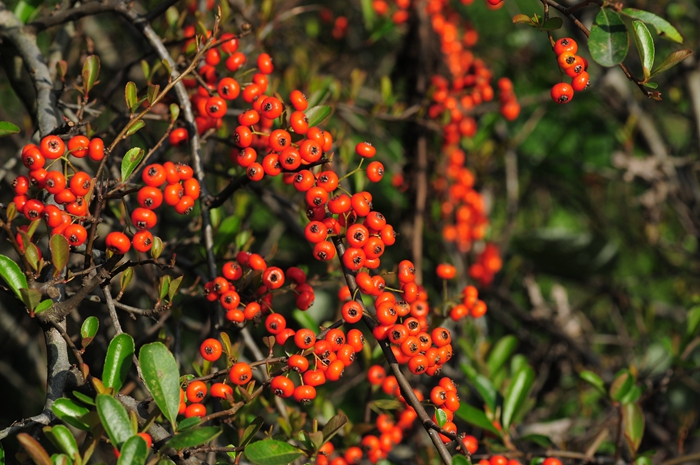- Scientific Name: Pyracantha fortuneana (Maxim.) H.L.Li
- Ref: J. Arnold Arbor. 25:420. 1944
- Synonyms:
- Photinia fortuneana Maxim.
- Pyracantha crenulata var. yunnanensis M.Vilm. ex Mottet
- P. gibbsii var. yunnanensis Osborn
- P. yunnanensis (M.Vilm. ex Mottet) Chitt.
- Chinese Common Name: 火棘 huǒjí
- Family: Rosaceae
- Genus: Pyracantha
- Distribution: Thickets, stream sides, roadsides; 500–2800 m. Fujian, Guangxi, Guizhou, Henan, Hubei, Hunan, Jiangsu, Shaanxi, Sichuan, Xizang, Yunnan, Zhejiang.
Shrubs to 3 m tall. Lateral branches short, thornlike; young branchlets rusty pubescent, dark brown and glabrescent when old. Petiole glabrous or initially slightly pubescent; stipules not seen; leaf blade obovate or obovate-oblong, 1.5–6 × 0.5–2 cm, both surfaces glabrous, base cuneate, margin serrate with teeth incurved, apex obtuse or emarginate, sometimes shortly apiculate. Compound corymb rather loose, 3–4 cm in diam.; peduncle subglabrous; bracts caducous, lanceolate. Pedicel ca. 1 cm, subglabrous. Flowers ca. 1 cm in diam. Hypanthium campanulate, abaxially glabrous. Sepals triangular, 1–1.5 mm, glabrous, margin entire, apex obtuse. Petals suborbicular, ca. 4 × 3 mm, apex rounded or obtuse. Stamens 20; filaments 3–4 mm. Ovary densely white pubescent apically; styles ca. as long as stamens. Pome orangish red or dark red, subglobose, ca. 5 mm; fruiting pedicel 2–5 mm; sepals persistent, erect. Fl. Mar–May, fr. Aug–Nov. 2n = 34*. (Flora of China)
